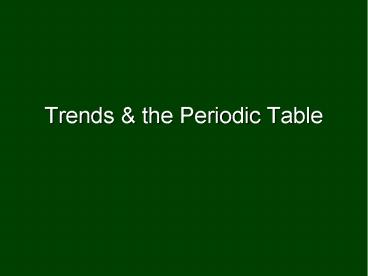Trends PowerPoint PPT Presentation
Title: Trends
1
Trends the Periodic Table
2
Trends
- more than 20 properties change in predictable
ways based location of elements on PT - some properties can be predicted
- density
- melting point/boiling point
- atomic radius
- ionization energy
- electronegativity
3
Atomic Radius
- Atomic radius defined as ½ distance between
neighboring nuclei in molecule or crystal - size varies a bit from substance to substance
4
X-ray diffraction pinpoints nuclei then
measures distance between them Cannot measure
electron cloud
5
Trends Atoms get larger as go down column ?
principal energy levels Atoms get smaller as
move across series ? PPP proton pulling power
6
Going down column 1
increasing energy levels as go down - makes
sense that atoms get larger in size
7
Li Group 1 Period 2 Cs Group 1
Period 6
8
Going across row 2
size atoms actually get a bit smaller as go
across row left to right - whats going on?
9
What do you remember about charge?
- opposites attract
- like charges repel
- largest influence on atomic size in order
- principal energy levels
- proton pulling power (PPP)
10
Effective nuclear charge
- Charge actually felt by valence electrons
- To calculate
- Atomic Number minus inner shell electrons
- Not same as nuclear charge or protons in
nucleus - Charge felt by valence electrons is attenuated
(shielded) by inner shell electrons
11
H and He only elements whose valence electrons
feel full nuclear charge (pull)
12
Lis valence e- feels effective nuclear charge of
1
13
Calculate effective nuclear charge
protons minus inner electrons
14
as go across row size tends to decrease a bit
because of greater proton pulling power (PPP)
15
- size ? as you go ? column
- size ? as you go ? row
16
Ionization Energy
- Definition amount energy required to remove
valence e- from atom in gas phase - 1st ionization energy energy required to remove
most loosely held valence electron (valence e-
farthest from nucleus)
17
Trends in ionization energy
- What do you think happens to the ionization
energy as go down column of PT? - As go across row?
decreases
increases
18
- valence e- in atoms effective nuclear charge of
1 - Cs valence e- lot farther away from nucleus than
Li - electrostatic attraction much weaker so easier to
steal electron away from Cs
19
- easier to steal electron from Li than from Ne
- Li smaller effective nuclear charge
- - valence electron farther away from
nucleus - Li has less proton pulling power than Ne
20
Trends in ionization energy
- Ionization energy decreases as go down column
- easier to remove valence electron
- Ionization energy increases as go across row
- more difficult to remove valence electron
21
Periodic properties Graph shows a repetitive
pattern (Note Doesnt have to be a straight
line)
22
Electronegativity
- ability of atom to attract electrons in bond
- noble gases tend not to form bonds, so dont have
electronegativity values - Unit Pauling
- Fluorine most electronegative element
- 4.0 Paulings
23
Trends in electronegativity
- Related to PPP
- Increases as go across row
- Decreases as go down column
- Remember F most electronegative element!
24
(No Transcript)
25
Reactivity of Metals
- metals are losers!
- judge reactivity of metals by how easily give up
electrons - most active metals Fr (then Cs)
- For metals, reactivity increases as ionization
energy goes down
26
Trends for Reactivity of Metals or Metallic
Character
- Increases as go down column
- easier to lose electrons!
- Decreases as go across row
- more difficult to lose electrons!
27
Reactivity of Non-metals
- Non-metals are winners!
- judge reactivity of non-metals by how easily gain
electrons - F most active non-metal
- For non-metals
- reactivity ? as electronegativity ?
28
Trend for Reactivity of Non-metalsDepends on
PPP
- Increases as go across row
- Decreases as go down column
- (shielded by more inner-shell electrons)
29
Ionic Size Relative to Parent Atom
- Depends if () ion or (-) ion
- How do you make a positive ion?
- How do you make a negative ion?
Remove electrons
Add electrons
30
How do you know if an atom gains or loses
electrons?
- Think back to the Lewis structures of ions
- Atoms form ions to get a valence of 8 (or 2 for
H) - Metals tend to have 1, 2, or 3 valence electrons
- Its easier to lose them
- Non-metals tend to have 5, 6, or 7 valence
electrons - Its easier to add some
- Noble gases already have 8 so they dont form
ions very easily
31
Positive ions (cations)
- Formed by loss of electrons
- Cations always smaller than parent atom
32
Negative ions or (anions)
- Formed by gain of electrons
- Anions always larger than parent atom
33
Allotropes
- Different forms of element in same phase
- different structures and properties
- examples C and O
34
O2 and O3 - both gas phase
- O2 (oxygen) - necessary for life
- O3 (ozone) - toxic to life
35
- Graphite, diamond
- both carbon in solid form
36
Graphite and Diamond both carbon in solid form

